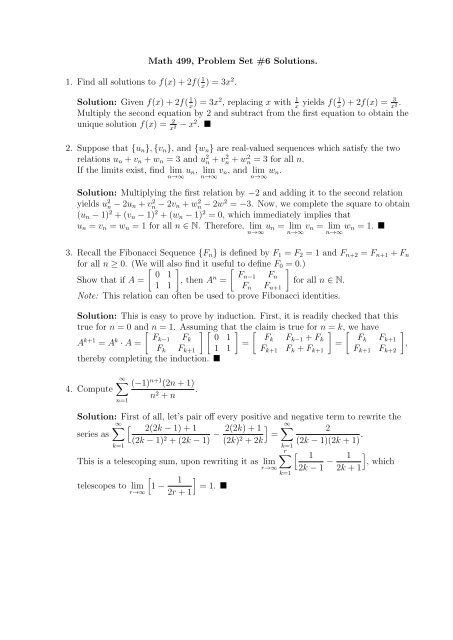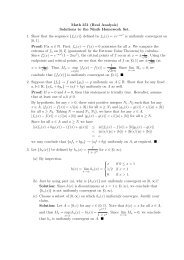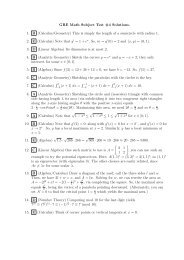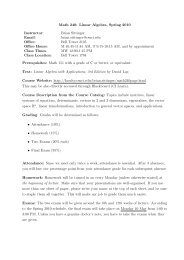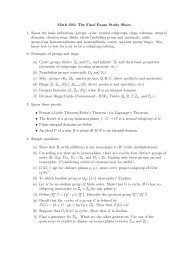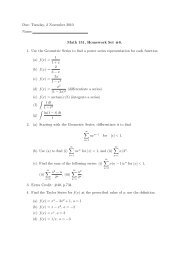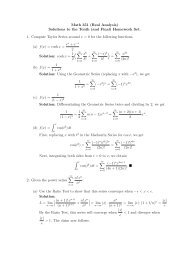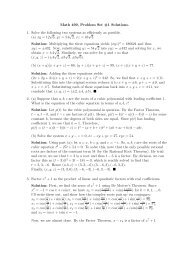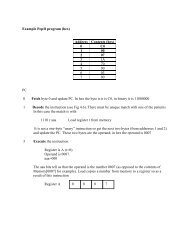Math 499, Problem Set #6 Solutions. 1. Find all solutions to f(x)+2f(1 ...
Math 499, Problem Set #6 Solutions. 1. Find all solutions to f(x)+2f(1 ...
Math 499, Problem Set #6 Solutions. 1. Find all solutions to f(x)+2f(1 ...
You also want an ePaper? Increase the reach of your titles
YUMPU automatically turns print PDFs into web optimized ePapers that Google loves.
<strong>Math</strong> <strong>499</strong>, <strong>Problem</strong> <strong>Set</strong> <strong>#6</strong> <strong>Solutions</strong>.<br />
<strong>1.</strong> <strong>Find</strong> <strong>all</strong> <strong>solutions</strong> <strong>to</strong> f(x) + 2f( 1 x ) = 3x2 .<br />
Solution: Given f(x) + 2f( 1 x ) = 3x2 , replacing x with 1 x yields f( 1 x ) + 2f(x) = 3 x 2 .<br />
Multiply the second equation by 2 and subtract from the first equation <strong>to</strong> obtain the<br />
unique solution f(x) = 2 x 2 − x 2 . <br />
2. Suppose that {u n }, {v n }, and {w n } are real-valued sequences which satisfy the two<br />
relations u n + v n + w n = 3 and u 2 n + vn 2 + wn 2 = 3 for <strong>all</strong> n.<br />
If the limits exist, find lim u n , lim v n , and lim w n .<br />
n→∞ n→∞ n→∞<br />
Solution: Multiplying the first relation by −2 and adding it <strong>to</strong> the second relation<br />
yields u 2 n − 2u n + vn 2 − 2v n + wn 2 − 2w 2 = −3. Now, we complete the square <strong>to</strong> obtain<br />
(u n − 1) 2 + (v n − 1) 2 + (w n − 1) 2 = 0, which immediately implies that<br />
u n = v n = w n = 1 for <strong>all</strong> n ∈ N. Therefore, lim u n = lim v n = lim w n = <strong>1.</strong> <br />
n→∞ n→∞ n→∞<br />
3. Rec<strong>all</strong> the Fibonacci Sequence {F n } is defined by F 1 = F 2 = 1 and F n+2 = F n+1 + F n<br />
for <strong>all</strong> n ≥ 0. (We[ will also ] find it useful [ <strong>to</strong> define F 0 ] = 0.)<br />
0 1<br />
Show that if A = , then A<br />
1 1<br />
n Fn−1 F<br />
=<br />
n<br />
for <strong>all</strong> n ∈ N.<br />
F n F n+1<br />
Note: This relation can often be used <strong>to</strong> prove Fibonacci identities.<br />
Solution: This is easy <strong>to</strong> prove by induction. First, it is readily checked that this<br />
true for n = 0 and[ n = <strong>1.</strong> Assuming ] [ that]<br />
the[ claim is true for n ] = k, [ we have ]<br />
A k+1 = A k Fk−1 F · A =<br />
k 0 1 Fk F<br />
=<br />
k−1 + F k Fk F<br />
=<br />
k+1<br />
,<br />
F k F k+1 1 1 F k+1 F k + F k+1 F k+1 F k+2<br />
thereby completing the induction. <br />
4. Compute<br />
∞∑<br />
n=1<br />
(−1) n+1 (2n + 1)<br />
.<br />
n 2 + n<br />
Solution: First of <strong>all</strong>, let’s pair off every positive and negative term <strong>to</strong> rewrite the<br />
∞∑ [<br />
2(2k − 1) + 1<br />
series as<br />
(2k − 1) 2 + (2k − 1) − 2(2k) + 1 ] ∞∑ 2<br />
=<br />
(2k) 2 + 2k (2k − 1)(2k + 1) .<br />
k=1<br />
k=1<br />
r∑ [<br />
1<br />
This is a telescoping sum, upon rewriting it as lim<br />
r→∞ 2k − 1 − 1 ]<br />
, which<br />
2k + 1<br />
k=1<br />
[<br />
telescopes <strong>to</strong> lim 1 − 1 ]<br />
= <strong>1.</strong> <br />
r→∞ 2r + 1
5. Consider y = f(x), where f(0) = f( 1 ) = 0 for <strong>all</strong> n ∈ N. If the graph of f(x) on [0, 1]<br />
n<br />
consists of the congruent sides of an isosceles triangle of height 1 for each n ∈ N,<br />
compute ∫ 1<br />
f(x) dx.<br />
0<br />
Solution: Since this integral represents the sums of areas of triangles with base<br />
length 1 − 1 and height 1 (for each n), we have<br />
n n+1<br />
∫ 1<br />
∞∑ 1<br />
( 1<br />
f(x) dx =<br />
2 n − 1 )<br />
= 1 (via telescoping sums). <br />
n + 1 2<br />
0<br />
n=1<br />
6. Compute lim<br />
x→1<br />
sin( √ x + 3 − 2)<br />
tan( √ x 2 + 5x + 3 − 3) .<br />
Solution: Here is a solution without L’Hôpital’s Rule.<br />
sin θ<br />
tan θ<br />
Using lim = 1, we also have lim = <strong>1.</strong><br />
θ→0 θ<br />
θ→0 θ<br />
Letting θ = √ x + 3 − 2 as well as θ = √ √ x 2 + 5x + 3 − 3, the limit in question is<br />
x + 3 − 2<br />
equivalent <strong>to</strong> lim √ . Now, we rationalise both the numera<strong>to</strong>r and<br />
x→1 x2 + 5x + 3 − 3<br />
denomina<strong>to</strong>r by their respective conjugates <strong>to</strong> rewrite this as<br />
((x + 3) − 2 2 )( √ x<br />
lim<br />
2 + 5x + 3 + 3)<br />
x→1 ((x 2 + 5x + 3) − 3 2 )( √ x + 3 + 2) = lim ( √ x 2 + 5x + 3 + 3)<br />
x→1 (x + 6)( √ x + 3 + 2) = 3<br />
14 . <br />
7. Let P (x) be a polynomial of degree 2012 such that P (k) = 1 k<br />
What is P (0)<br />
for <strong>all</strong> k = 1, 2, ..., 2013.<br />
Solution: The key idea is <strong>to</strong> consider Q(x) = xP (x) − <strong>1.</strong> Then, Q(k) = 0 for <strong>all</strong><br />
k = 1, 2, ..., 2013. So, the Fac<strong>to</strong>r Theorem yields Q(x) = A(x − 1)(x − 2)...(x − 2013)<br />
for some constant A. However, since Q(0) = −1, we conclude that A = 1<br />
2013! .<br />
Having determined Q(x), now we can compute P (0). Since P (x) is a polynomial, it is<br />
continuous at x = 0 in particular. So, we can write that<br />
1 + Q(x) 1 + 1 (x − 1)(x − 2)...(x − 2013)<br />
2013!<br />
P (0) = lim = lim<br />
.<br />
x→0 x x→0 x<br />
1<br />
By L’Hôpital’s Rule, we have P (0) = lim<br />
x→0 2013! · d<br />
[(x − 1)(x − 2)...(x − 2013)].<br />
dx<br />
To compute this fairly painlessly, using logarithmic differentiation yields<br />
1<br />
[<br />
P (0) = lim<br />
x→0 2013! · (x − 1)(x − 2)...(x − 2013) · 1<br />
x − 1 + 1<br />
x − 2 + ... + 1<br />
]<br />
.<br />
x − 2013<br />
Fin<strong>all</strong>y, we conclude that P (0) = 1 + 1 2 + ... + 1<br />
2013 .
8. For any n > 0, evaluate<br />
∫ ∞<br />
0<br />
⌊x⌋e −nx dx.<br />
Solution: Due <strong>to</strong> the definition of the floor function, split this integral at every<br />
∫ ∞<br />
∞∑<br />
∫ k+1<br />
integer value: ⌊x⌋e −nx dx = k · e −nx dx.<br />
This equals<br />
0<br />
k=1<br />
∞∑<br />
k(e −nk − e −n(k+1) ) = (1 − e −n ) ·<br />
k=1<br />
k<br />
∞∑<br />
k=1<br />
k<br />
e nk =<br />
e n<br />
(e n − 1) 2 .<br />
To evaluate this latter sum, differentiate the geometric series and then multiply both<br />
x<br />
sides by x:<br />
(1 − x) = ∑ ∞<br />
kx k . Fin<strong>all</strong>y, let x = 1 2 e . n<br />
k=1<br />
9. Show that 14x 2 + 15y 2 = 7 2012 has no integer <strong>solutions</strong>.<br />
Solution: Show that such an integer solution exists. Since 14x 2 and 7 2012 are both<br />
divisible by 7, we see that y is divisible by 7. Writing y = 7m for some integer m, the<br />
equation simplifies <strong>to</strong> 2x 2 + 15 · 7m 2 = 7 2011 . As before, now we see that x is divisible<br />
by 7. So writing x = 7n for some integer n, we obtain 14n 2 + 15m 2 = 7 2010 , which is<br />
just like the original equation, but with the power of 7 decreased by 2. So, we can<br />
repeat the above argument until we reduce the equation <strong>to</strong> 14r 2 + 15s 2 = 1 for some<br />
integers r and s. However, this equation clearly has no integer <strong>solutions</strong>, and so we<br />
have reached a contradiction.


